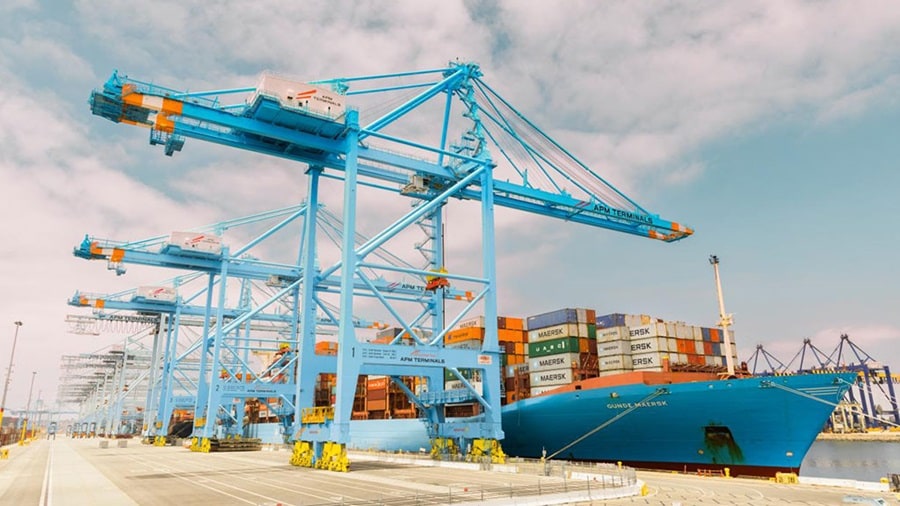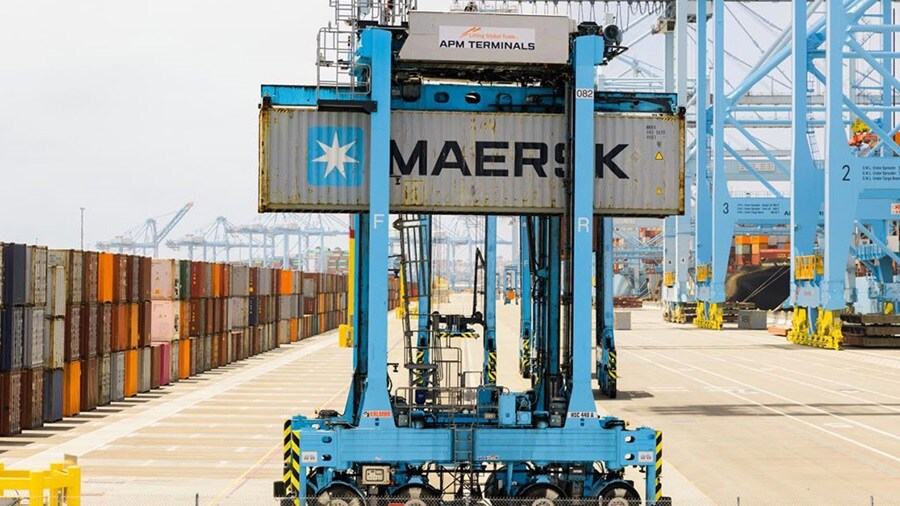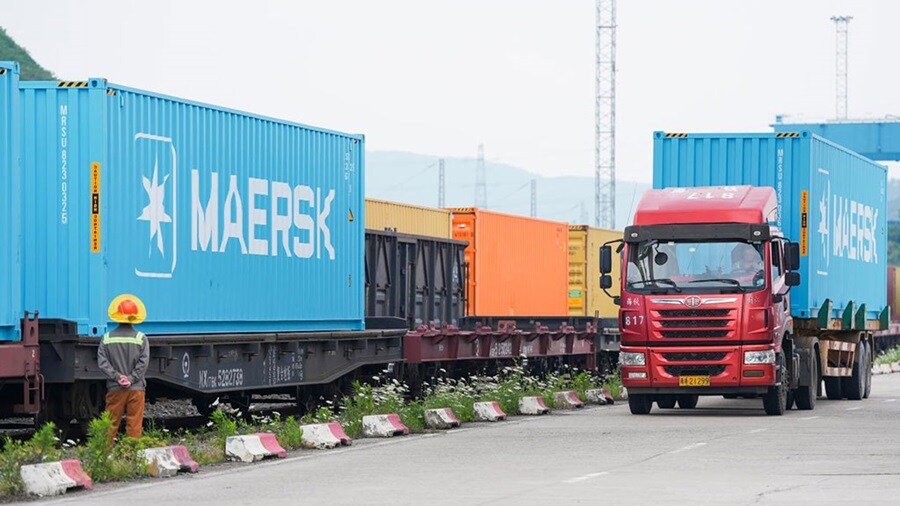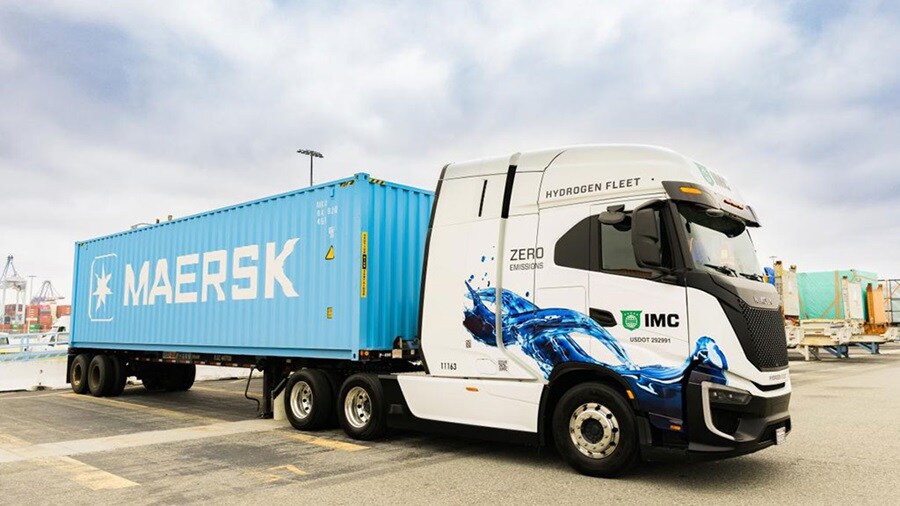As we enter the last quarter of 2025, businesses are navigating mixed signals: Golden Week slowdowns in Asia, uneven flows amid ongoing tariff reviews, and service adjustments across key trades, alongside resilient demand on non-U.S.-China corridors. Notably, Far East Asia-U.S. container volumes are up, underscoring continued U.S.-bound flows from Southeast Asia. Inland networks remain sensitive to capacity and regulatory changes.
This month’s update gives clear actions on ocean, LCL options, customs readiness, inland planning, warehousing strategy, and ground freight capacity so you can protect Q4 arrivals and prepare for holiday demand.
To receive the Maersk North America Market Update in your inbox, sign up for our logistics newsletter here and update your preferences when prompted via email.
Ocean Update

Europe to North America: Demand remains soft following the summer slowdown and the pre-tariff import surge in June and July. We expect a gradual pickup from early October as businesses position inventory for Thanksgiving and Black Friday, with a step-up in late-October sailings for November arrivals. Vessel capacity is available across key North Europe and Mediterranean gateways. Utilize flexible load ports and alternative routings whenever possible to secure earlier departures.
Many businesses are booking only 1–2 weeks before departure during the current slack summer period, which compresses equipment and space planning. For October cargo, return to a 3–4 week booking window to secure preferred sailings and inland connections.
Indian Subcontinent, Middle East, and Africa to North America: US tariffs on India have reduced cargo flows from India. If you ship from India, expect turbulence until the U.S. Supreme Court completes its review of the lower-court ruling related to tariff authority in November.
We have withdrawn the Peak Season Surcharge (PSS) for cargo into the US West Coast. For other lanes, please refer to the current PSS levels in our advisory. We will share any updates for October when confirmed.
Space is available with our MECL service, which continues on a weekly basis. If you need West Coast capacity, we can accommodate cargo into Los Angeles/Long Beach.
For Africa imports, the cocoa season begins in late October so book November-December vessel space early and expect earlier cut-offs on cocoa lanes. If you plan to move cut flowers, consider allocating cool-chain capacity early. For South Africa, our new October transshipment service via Europe provides reliable routings from Durban, Port Elizabeth, and Cape Town to U.S. East Coast ports. Use it to secure schedules and reduce transit variability during peak periods. From East Africa, apparel volumes remain strong ahead of the holidays. Please lock allocations and share 4–6 week forecasts so we can align space and equipment.
Asia-Pacific to North America: We have entered China’s National Day Golden Week (October 1–8), when many factories and businesses close for the week. In this period, we typically see an increase in blankings and schedule/network changes. We have announced our blank sailings on both our Asia-to-North America West Coast and East Coast services, as well as the temporary suspension of our TP9 service.
Following Golden Week, we enter what is typically considered a calmer period. We appreciate our customers' support in ensuring they deliver on their allocation fulfillment across our services, allowing for the best possible planning.
Our East-West (Gemini) network continues to deliver strong reliability with our Transpacific Eastbound services.
USTR Section 301 Regulatory Update:
Effective October 14, 2025, the U.S. will begin phasing in new service fees for maritime transport services of Chinese-owned and Chinese-built vessels calling U.S. ports, introduced gradually over a three-year period. We do not plan to apply any surcharge in connection with this rule, and we do not anticipate changes to our U.S. port rotations or your existing service plans. We will continue to monitor the rollout and keep you informed so you can plan with confidence.
Intra-Americas: We organize our Intra Americas network into three regions so you can plan by trade: East Coast South America, Caribbean and Central America, and West Coast South America services.
East Coast South America: We are implementing targeted adjustments to improve reliability and protect transit times. On the UCLA service, the omission of Mobile, Salvador, and Navegantes continues, and reliability has increased by 45% year-to-date. On Tango, the Norfolk omission remains in effect through year-end; coverage is provided via TP12 with transshipment in Cartagena, thereby avoiding barge costs. Reliability has improved by over 75% since January, supporting time-sensitive cargo. On Brazex, our participation ends with the CMA Berlioz 540s departing Veracruz in early October; your coverage will then transition to UCLA and Gulfex, where we do not expect customer impact. On Gulfex, we removed Rio de Janeiro to add a buffer in the rotation; space is open for new opportunities. In Manaus, the river level is 23.91m; as long as levels stay above 19.30m, the Low Water Surcharge will not apply.
Caribbean and Central America (Atlantic Coast): Network stability has improved following operational changes. Our NAE service has stabilized following the terminal change in Savannah. As the reefer season peaks from the West Coast, expect full vessels from Manzanillo, Panama, with no reported issues. SAE performance has improved, with vessels operating on schedule; we remain proactive to maintain high reliability. GOEX will continue alternating northbound omissions in Central America to stabilize the wider rotation; minor delays may persist. AGAS is stable with no reported issues. The new Gemini shuttles strengthen U.S.–Cartagena connectivity: AM1 links Miami/Jacksonville with Cartagena; AM2 connects Cartagena with Tampa, New Orleans, and Progreso in both directions.
West Coast South America: WCCA1 and WCCA3 merged in July, now providing weekly coverage to Corinto and Acajutla. WCCA2 is operating to schedule. WCCA1 expects on-time performance on a weekly loop: Balboa–Corinto–Quetzal–Lázaro–Acajutla–Balboa. The Caldera Feeder remains on schedule, with potential weather-related delays in Caldera. The Atacama, Peru, and Guayaquil feeders are operating on time.
Peru fruit season: We are positioned to support fast market entry with improved transit times. CLX is reinstated in Paita with a direct Paita–Philadelphia connection in 13 days, arriving via NAE rotations on Mondays to land fruit at the start of the week; the first call was on September 9. The Peru Feeder continues to provide complementary coverage from Paita and other Peruvian ports, keeping options flexible.
To receive the latest updates on your cargo, sign up for ETA notifications or check schedules on Maersk.com. For operational updates in our “Weekly Reader,” subscribe to our advisories at Maersk.com/newsletter.
Less than Container Load (LCL) Update

In the current U.S. import landscape, where tariffs have increased and airfreight rates remain high amid ongoing global disruptions, Less than Container Load (LCL) ocean shipping emerges as a cost-effective alternative to both Full Container Load (FCL) and airfreight options. LCL allows shippers to consolidate smaller cargo volumes, paying only for the space used rather than an entire container, or alternatively, premium air rates.
This is particularly advantageous for businesses managing fluctuating inventory needs, as it offers a balance of affordability, flexibility, and reliability without the inefficiencies of underutilized FCL space or the expense of air transport.
For businesses that don’t need all their inventory replenished and can order a bit earlier to avoid air freight, they can save up to 80% (depending on lane, weight, lead time, etc.) on door-to-door logistics by choosing LCL. This option goes a long way to managing cash flows and balancing margins against tariff increases.
Customs Update

The United States has implemented new tariffs ranging from 10% to 50% on a broad range of imports, with a notable impact on copper, auto parts, and goods originating from India and Brazil. These measures are already influencing supply chains, and you should anticipate higher landed costs, potential delivery delays, and increased pressure to adjust sourcing and inventory strategies accordingly.
As we previously shared, a federal appeals court ruled in late August on tariffs imposed under the International Emergency Economic Powers Act (IEEPA). Enforcement remains in place until mid-October pending potential Supreme Court review.

In the U.S., ports and rail ramps are operating smoothly, and drayage turn times remain stable. In Q2 2025, many carriers closed, and bankruptcy filings in the logistics sector continued. If you rely on the spot market, build a buffer and secure capacity early, as appointment availability may be strained in the near future.
To protect your schedules and avoid demurrage, anchor your core lanes with reliable providers. Our in-house trucking network, with integrated partnerships across 10+ markets and 42 years of drayage experience, provides a stable solution for shippers.
First, driver capacity: two U.S. policy actions may affect short-notice availability: USDOT guidance directing inspectors to place drivers out of service for English language proficiency violations, and a U.S. State Department pause on processing certain work visas for commercial truck drivers pending a screening/vetting review. We recommend keeping contingency options ready.
Second, carrier population: higher insurance and compliance costs may push more small carriers out; review your carrier mix and exposure to single-truck operators. Third, New Jersey’s proposed labor rules: the state is considering standards similar to California’s AB5’s law that would make it easier to classify independent contractors as employees, with finalization expected in late 2025. If enacted, owner-operators could face limits that reduce their ability to haul for multiple companies in a day, and carriers could face additional costs and complexity impacting service offerings. If you have drayage in New Jersey, map which lanes rely on owner-operators, identify alternate routings and capacity options with your providers, and build operational flexibility now to mitigate disruption risk.
The Canadian inland market remains active, especially on the West Coast. Railcar shortages and increased volumes are contributing to port congestion, with some containers waiting 1–2 weeks for rail loading. In the East, Montreal is experiencing terminal congestion, draft restrictions on the St. Lawrence that impact schedules, labor disruptions at select terminals, and limited railcar availability. Road construction around Turcot, Ville-Marie, and the La Fontaine Tunnel is adding variability to appointments. Across the Northeast U.S., dwell times in Newark remain elevated, and mild congestion is likely in October, which is expected to slow Canada-bound rail cargo. Reefer trucking out of the U.S. East Coast is tight under seasonal pressure.
Here is how we are responding and how you can plan. We are sourcing alternative trucking capacity, particularly for reefer and time-sensitive moves from the U.S. East Coast, working with terminals to reduce dwell times, and coordinating with Montreal-based carriers to adjust schedules around roadworks and variable vessel arrivals. You should plan extra lead time for inland rail and trucking, share your reefer, overweight, and urgent cargo needs early to secure capacity, and allow flexibility on Montreal delivery appointments due to congestion, construction, and uneven vessel discharge. Looking ahead, Montreal congestion may begin to ease later in October, but it is unlikely to normalize before the fourth quarter. Low St. Lawrence water levels may continue to restrict vessel capacity and create irregular inland flows, and reefer trucking constraints are expected to persist through October as citrus volumes increase.
Warehousing Update

Tighter U.S. trade rules, including changes to de minimis and tariffs on Chinese imports, are adding uncertainty and slowing long-term space commitments. Many brands are also diversifying production away from China and testing alternative sourcing. They are reassessing their distribution strategy, running center-of-gravity studies, consolidating DCs to simplify inventory, and looking to reduce outbound costs without sacrificing speed. Retailer drop shipping continues to grow as shippers seek flexible fulfillment.
We’re also seeing more strategic insourcing models that balance control with scalable operations. Our recent article highlights an 11-year high vacancy rate and rising 3PL-led leasing, with hybrid setups helping brands pivot faster under tariff fluctuations.
Many shippers are routing some fulfillment outside the U.S., including DTC and B2B distribution from Canada or Mexico, while building business continuity plans for disruptions from geopolitics to weather. We also see provider consolidation to move faster, and in categories like fashion, home, and beauty, two to five day delivery expectations are driving localized inventory and deeper integration with domestic networks.
To address these shifting dynamics, companies are securing overflow space and evaluating warehouse options nationwide. Our Supply Chain Design team is supporting network optimization analysis, while Engineering is tailoring solutions for wholesale, retail, and D2C orders with varying levels of automation. The Small Parcel team is providing rate shopping tools, and Ground Freight is offering LTL, FTL, and final-mile solutions. For retailers, drop shipping can now be enabled within one to two weeks, allowing rapid onboarding and fulfillment flexibility.
Looking ahead, rising costs for rent, labor, automation, materials, and last mile will pressure margins. Focus on efficiency, targeted automation, and flexible fulfillment models, including on-demand capacity and 3PL partnerships. With one of the largest warehouse footprints in North America and globally, we can support you end-to-end or selectively where you need it most.
Ground Freight Update

The market is going through a period of strong headwinds. What this means for you: lock your core lanes under contract to capture today’s pricing and use spot only for true overflow. Share 2–6-week forecasts so we can stage equipment and appointments and cut dwell at origins and DCs. Add small buffers to time-definite moves to protect launches and promos in case of capacity blips. Review your carrier mix; reduce concentration with single-truck operators and dual -source across assets to keep service stable.
If you’re moving with us at Maersk, we are preparing nationwide with more than 1,000 trucks and 4,500 trailers. Our flexible LTL and FTL solutions include time-definite options where needed. For a deeper dive into demand, capacity, and rate trends that may influence your planning, see our latest U.S. Ground Freight Market Outlook.
In Canada, service is consistent on most lanes. Seasonal volumes are ramping up, particularly in retail and lifestyle, driven by Halloween demand and early holiday inventory. We see slight tightening eastbound from British Columbia to Ontario/Quebec, while domestic volume is steady elsewhere. Lock capacity early for promotional and holiday restocks, as lead times are expected to tighten by mid-October. We are securing reliable weekly departures on key corridors, including British Columbia–Ontario, Greater Toronto Area–Montreal, and intra-Ontario, to keep store-ready freight moving. Conditions look favorable through October, with higher demand likely into November.
More News & Insights from Maersk from around the world
- Maersk launches “Maersk Trade & Tariff Studio” helping global supply chains navigate tariff volatility and complexity
- Barry Callebaut and Maersk Celebrate Official Opening of One of the Largest Cocoa Bean Warehouses in Asia Pacific
- Safety at Speed: How Maersk Delivered High-Risk EV Batteries in 72 Hours, Fully Compliant and Incident-Free
- Maersk Supply Chain Management Forum 2025: Turning Uncertainty into Opportunity
Visit our Insights Hub where we share the latest trends in supply chain digitization, sustainability, growth, resilience, and integrated logistics.
Useful links
To sign up for the Maersk North America Market Update newsletter, click here and update your preferences when prompted via email.
Check Maersk market updates from across other regions by clicking here.
无论您需要什么,我们都可以随时为您提供帮助
I agree to receive logistics related news and marketing updates by email, phone, messaging services (e.g. WhatsApp) and other digital platforms, including but not limited to social media (e.g., LinkedIn) from A. P. Moller-Maersk and its affiliated companies (see latest company overview). I understand that I can opt out of such Maersk communications at any time by clicking the unsubscribe link. To see how we use your personal data, please read our Privacy Notification.
By completing this form, you confirm that you agree to the use of your personal data by Maersk as described in our Privacy Notification.

